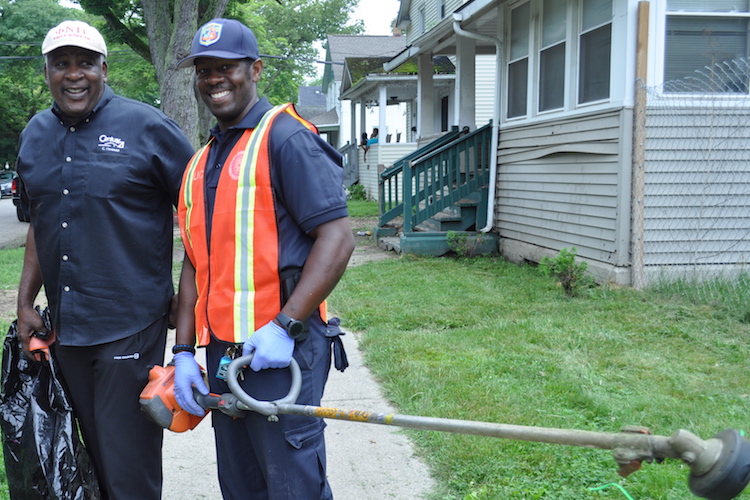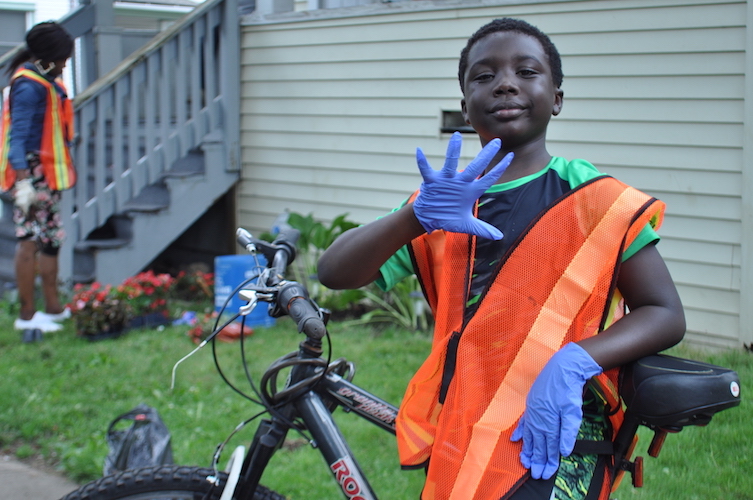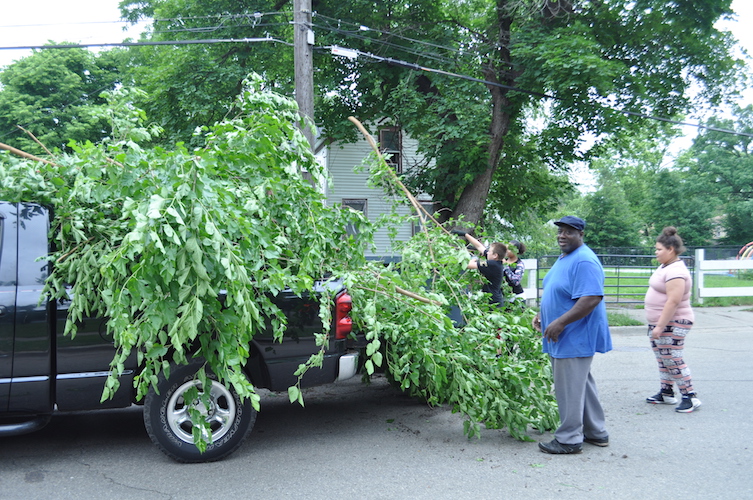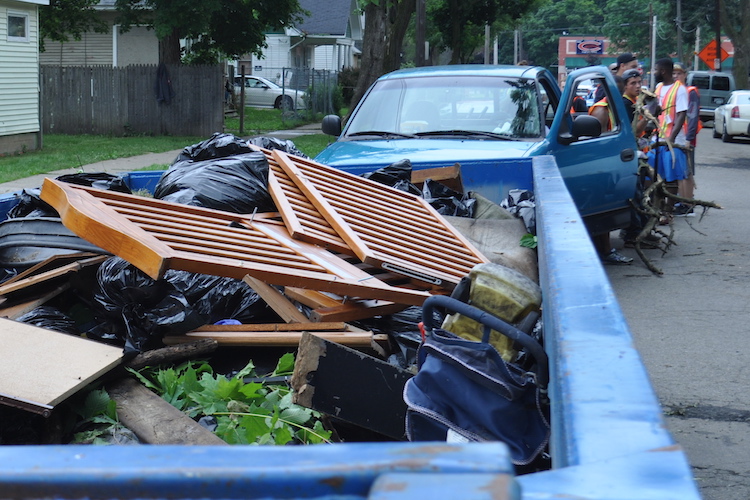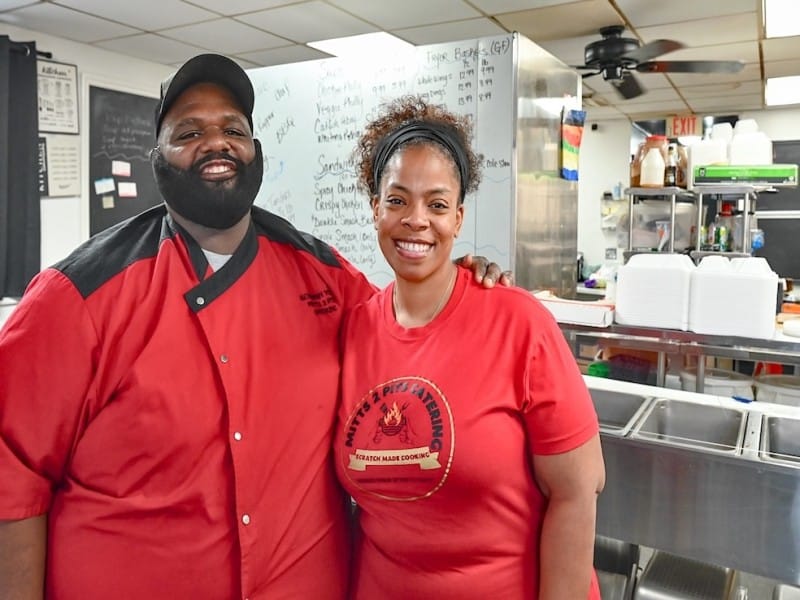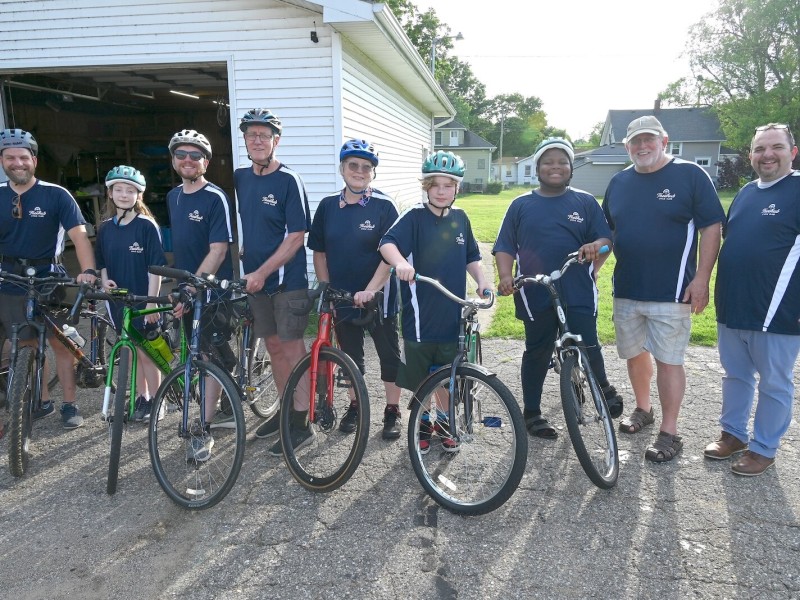For families working through recovery, Mothers of Hope offers care, compassion, and information
Sobriety is the best hope that women with substance abuse disorder can receive and Mothers of Hope offers that hope.
Editor’s note: This story is part of Southwest Michigan Second Wave’s On the Ground Northside series.
If you think of the Ultimate Family Reunion when you hear the name Mothers of Hope there is a good reason for that. For 10 years, the nonprofit organized the one-day event that brought out thousands to have fun and food together and also to learn more about services and agencies offering assistance to those in need.
The first year the event — planned for teenagers as safe place to be, away from Ku Klux Klansmen rallying in downtown — was expected to draw 300. It drew 1,200 people instead.
With such a positive response from the community, Mothers of Hope continued the event for three more years then took a year off to organize as an independent nonprofit. When they restarted the reunion the following year with a focus on health and education it grew again and just kept growing. It took place in Spring Valley Park for a number of years, a venue large enough to handle the 3,000 to 5,000 people and 70 community organizations who turned out.
Typically, free food and the other elements of the reunion came to $25,000 in expenses for the day. “Because of the work it took to organize it, to raise the funds, and without having any paid staff it just grew too big for us,” says Gwen Lanier, president of the board of directors for Mothers of Hope.
Ten years was a good run, and after a successful event last year at La Crone Park, Mothers of Hope decided it was time to turn its efforts elsewhere.
The new direction for Mothers of Hope builds on its mission and origins as an organization formed to help women, their families, and their community rise above substance abuse disorders.
It’s a timely decision considering the extent of the national opioid crisis. In the office from which she works as a peer counselor at Ministry with Community, Lanier turns to a shelf and pulls out a Kalamazoo County Health and Human Services report released in January that details what is happening locally. In 2016, at local emergency departments, an average of 24 Kalamazoo County residents was treated each month for unintentional opioid overdoses, 13 for heroin, 11 for other opioids.
From 2015 to 2016 the number of drug-related deaths more than doubled — from 33 to 72. Most of these deaths involved opioids. Accidental opioid-related deaths doubled from 29 to 59 over the same time period, for an average of five per month. The highest rates of unintentional opioid overdoses were in the zip code areas 49007, 49034 (Climax) and 49001.
Accidental deaths in all categories of opioid use increased from 2015 to 2016, with accidental opioid-related deaths doubling from 29 to 59, according to a report by County Medical Director William Nettleton and Kim Kutzko for the Kalamazoo County Health and Human Services Department.
In the first nine months of 2017, there were 47 accidental, drug-related deaths; 38 involved opioids and reports of such deaths. The report concludes it will take a strategy that employs prevention and education, supply and control of opioids, treatment, and harm reduction to address the epidemic. And the report says it will take collaboration between public health, law enforcement, healthcare institutions, behavioral and mental health providers, substance use treatment providers, nongovernmental organizations, nonprofits, and other community partners to deal with the opioid epidemic.
Mothers of Hope wants to be part of the solution and a donation from the Kalamazoo County Land Bank is critical to that work.
Mothers of Hope has been given a house at 603 Ada that it now uses as its headquarters. “We would like to see agencies that deal with substance abuse do an outreach there,” Lanier says, “so that people that suffer who from substance abuse or families members of people that suffer from substance abuse can come there and meet with those agencies instead of going across town, so they’ll feel like it’s safer. And I’m looking forward to a 12-step program there Saturday mornings at 10 o’clock.”
She’s also been in conversation with prostitutes working nearby, asking them to determine the kind of once-a-week program that would help them. Lanier would like to see the programs up and running by Oct. 1, with board approval.
Mothers of Hope also envisions building on property adjacent to the house where they are headquartered. They see a community-based location for those recovering from substance abuse disorders, something that has not been available since Safe House on Paterson closed several years ago, Lanier says. They’re also working to be good neighbors and a leader in organizing those who live there.
“Before we moved into the house, we decided to go into the community right there and organize a block club of the residents, which we did,” Lanier says. “And they named themselves Action in the Neighborhood.” They are meeting regularly and have undertaken their first big initiative to revitalize the neighborhood.
The block club encompasses Ada, Lawrence, Florence, and Simpson streets and Burrell and Woodbury avenues. “Out of everything I’ve ever had the privilege to work on,” Lanier says, “that has been the most rewarding thing because those residents have actually organized. They’re doing really good.”
A community-based hub where people can come for support in dealing with recovery takes the Mothers of Hope back to its earliest days.
Before there was a Mothers of Hope there was a group of women in recovery who had been brought together as an advisory group for a committee that wanted to establish support and transitional programs for recovering women and their children. The committee had proposed a space where women could transition from substance abuse disorder to sobriety without being separated from their children. It was to be named Laura’s House for Laura Scheppach, a nurse who dedicated her life to helping low-income women in recovery.
But after three years of planning and 18 months working with the women’s group, when it came time to seek funding for the project in 2001 at least three funders rejected the idea. The attacks of Sept. 11 had just happened and all available resources were going into existing programs. No new programs were being funded, Lanier says.
The committee to establish Laura’s House disbanded, but the women who had been on the advisory committee wanted to keep working together. In fact, they found that the work was helping with their own recoveries. They organized as the Mothers of Hope and started to work with women and families. They started out giving informational presentations and then focused on their signature event. Today the volunteer-led nonprofit continues to work in the community with an array of programs led by an active board and 200 volunteers. Lanier’s daughter, County Commissioner Stephanie Moore, also works with the group.
One of those instrumental in bringing Mothers of Hope into the world was Dr. Michael Liepman, a founder of Mothers of Hope and an addiction psychiatrist. Liepman and Lanier met when the women were first invited to advise those planning Laura’s House. Lanier tells the story of how she packed extra lunches anticipating that some of those attending would not have time or means to pack one of their own. She ended up sharing a sandwich with Liepman. It was the beginning of a working relationship that saw him helping the organization in many ways, including work on the Ultimate Family Reunion.
His family continues to assist the Mothers of Hope. “They’re a small group but they’re a powerhouse,” says Aaron Liepman, whose father died in 2016. “They do a lot of great things. They have done the Family Reunion for 10 years and they are now branching out. They’ve started a music program and piano lessons for kids that don’t have great opportunities. I mean, who wouldn’t support that?”
Liepman goes on to say, “Their heart’s in the right place. It’s just they’ve got a finite amount of resources. So we try to help bolster that with what we can provide.
“It sounds like they’re doing great things in the neighborhood with the new home that they have (on Ada Street). It sounds like it’s kind of picking up critical mass already, and they’ve done some revitalization of the neighborhood. And the community is starting to rally around it. That’s amazing. That’s taking a little thing and making a big thing. And, that’s exactly the kind of thing that deserves to be supported. You can pour money into some of these big things, and it just gets lost in administration. These women are doing heavy lifting with small tools. So they’re really just amazing. They’ve got the willpower, the wherewithal, and the motivation. And they live there. So it’s great for the community.”
Before he died, Dr. Michael Liepman was the recipient of the Elizabeth Upjohn Healing Families Award. At the ceremony, Aaron Liepman met Lanier and they have maintained their connection. “I’ve been really happy to be able to continue supporting something that I know my dad felt really strongly about. We feel like it’s important to continue the legacy as long as we can because he gave. The fact that he gave of his time is the true signal that it’s something that he valued.”
Lanier pours so much of her time and energy into Mothers of Hope because she knows first-hand what it means both to be addicted and to be in recovery.
“I was a — you can print this — a falling down drunk daily and a cocaine IV shooter as regular as I could. I just celebrated 30 years clean this past Monday. Who would have thought? I wouldn’t have thought. If somebody had told me that, in early recovery, I would have never believed them,” she says with a laugh. “I went to treatment three times and each time I stayed cleaner than the time before then. Finally, I got it all. And part of that was because Safe House was available, somewhere for me to go every day. That’s why we’ve got to build a building because we got to have somewhere for people to go every day so that we can nourish them back to health.
“When I started the process of getting clean in a detox, it was so hard. Man, it was so hard. I didn’t think I was ever going to get it. I had no idea that I was going to really get a chance to have a life. I definitely didn’t think I would ever see my kids again. I just knew I was going to die on the streets from an OD. I had surrendered to it.” She believes it is through the grace of God that she recovered and was sober by 1988.
Lanier started at Ministry with Community in 1992 as a part-dishwasher and eventually was hired for the job she has today. “I love my job because I’m a peer support specialist and I get to work with people just like me. I get to help them get in treatment. I get to cry with them. Unfortunately, I get to see some of the people that I work with pass away from ODs and I work with their families afterward.
“I’m just trying to give hope and let them know that I believe in them because it happened for me. But it’s work. It’s not free. You got to work. You got to put something in to get something out. So I get to tell that to people every day. I’m just trying to share love and hope.”
When a parent is an addict it affects those around them. “I think that sometimes when people talk about substance abuse, they don’t really include the people it affects in the household, especially children,” Lanier says. “And they never really research what becomes of those kids. They don’t all end up being substance abusers.”
She asked Second Wave to talk with her son, Beryl Wilson Jr. to emphasize her point.
Wilson, who is a retired Marine, has put behind him any damage done in his mother’s worst years as an addict. In fact, today he calls her his best friend, a person he relies on to be fully honest with him and he is a person she turns to when she needs a sounding board.
“She’s definitely an inspiration,” Wilson says, “and I know if she can kick the addictions and the habits that she had then there’s no excuse why any of us can’t overcome any challenges that we have. … The fact that she’s sober and coherent, that’s a big deal.”
As his mother’s addiction worsened the children went to live with various relatives. Ultimately, he gives his parents credit for mending the family when Lanier succeeded with her treatment, both of them were there when they were needed most. He says that the example she showed at work and by getting her children involved in church and activities such as Boy Scouts and Brownies helped give them a foundation that they could return to when the worst of it all was over.
“My mom clearly, you know, was addicted, with a habit. And clearly, it had a direct impact on her family and our circumstances. And it was kind of infectious. I got into some things that were nefarious and unscrupulous when I was surrounded in drug activity and that lifestyle,” Wilson says. “But we didn’t start out like that… My mother tried to build a foundation for us. Basically, that let us know right from wrong and just to be decent human beings. So by the time her addiction occurred, we already had a sense of what direction we should be going in or what was intended for us. So when that stuff happened — it did affect and impact a lot of our decisions and circumstances — but at the end of the day, what’s important and what’s right and what’s wrong was instilled in us long. So for me and my siblings, I can say that that’s what really got us through that.
“We kind of went full circle and we’ve arrived back at where we originally started. And that’s essentially the way I look at it. A couple of those curves were pretty tough, but I don’t hold it against my mother. And I know she goes out of her way now to try to repay us for the times that she knows that she wasn’t probably the best parent.”
He sounds particularly proud of what he describes as his mother’s crown jewel, her ability to bring people together around a cause. “She has the ability to coalesce people and to get her volunteers, her staff, and her board members to coalesce.”
He has seen that in action when he has worked seven of the 10 years of the Ultimate Family Reunion. He has come up from his home in Atlanta where he moved to live with his father at age 15 to do whatever needed to be done to tie up any loose ends for the reunion. Five of those seven years his son came with him share the work.
“I feel great about being able to, one, be afforded the opportunity to advise her and two, being able to give her what I believe to be a solid piece of advice. So I’d say the organization is great,” Wilson says. “They’ve stuck to their mission statement over the years. Now they have expanded their outreach and their benevolence, but the root mission is still the same.”
Mothers of Hope Programs
From the Womb
An event in September to discuss trauma that women experience from birth on and information on how to better care for oneself, featuring presenters coming from Atlanta, Georgia, and Chicago.
Sistas Circle Roundtable
Weekly networking, troubleshooting and Sista support for women who need help navigating systems while receiving encouragement to make it through tough situations.
Real Life… Real Talk: Men’s Group Discussions
This is a brotherhood-based community support network that empowers men through dialogue, skill development, and service. This network provides a safe, comfortable, and nonjudgmental place of respect for men to discuss the challenges they face and the best ways to overcome them.
Sistas Can We Talk/Man Cave
Mothers of Hope’s signature series where women and men of all ages can freely discuss their concerns about their lives, families, and community.
The Michael Liepman Christmas Party
Free gifts at Christmas will go to 50 children, up 10 from 2017. There will be games and an appearance by Santa Claus. On a Wish Board children leave their wishes, often wishes for things like better health for a grandparent or a home.


